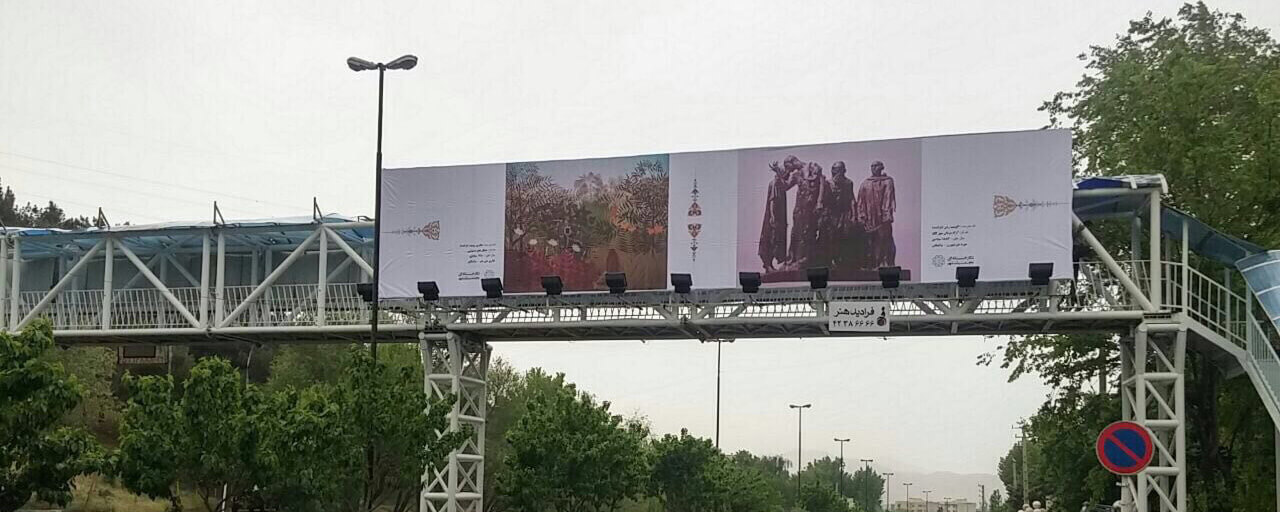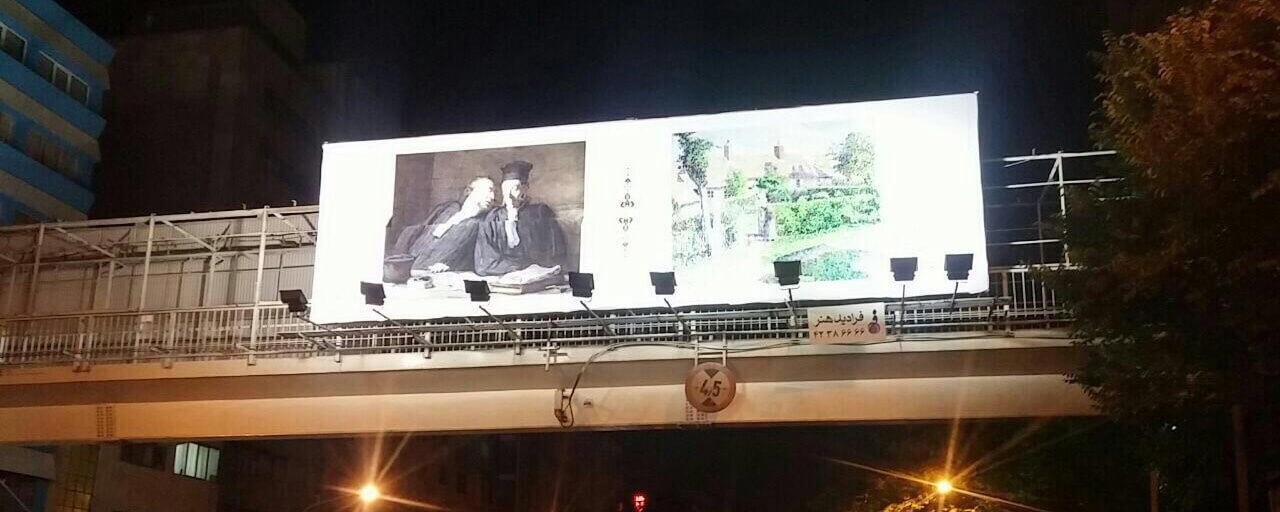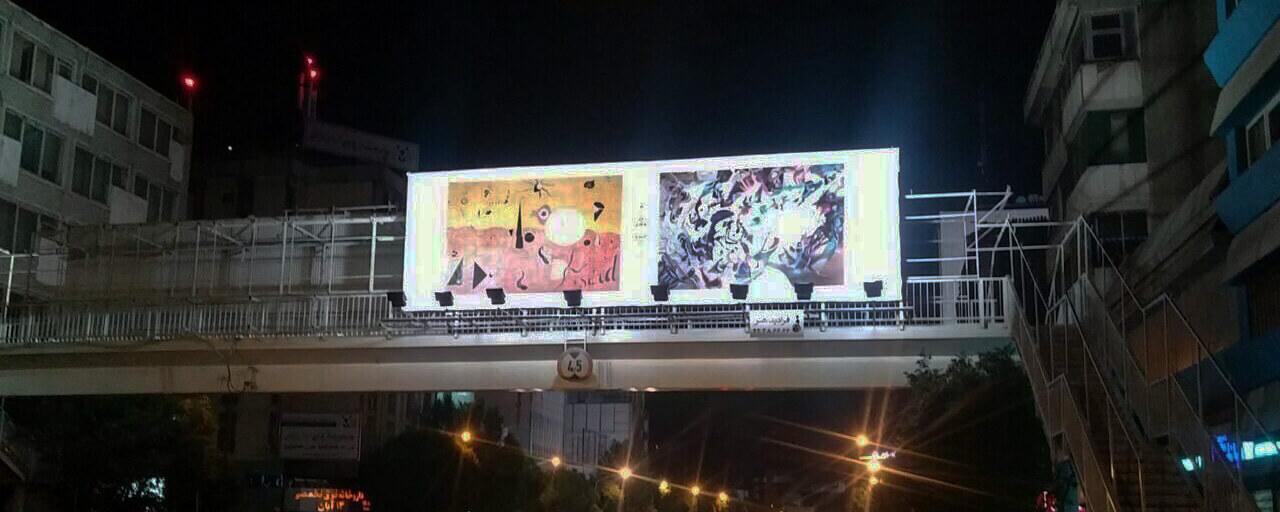The presence of “Faradid Honar” in the plan of “gallery the vastness of a city”, a plan that went from 15 to 26 May this year and could bring a new color to the face of Tehran, displaying more than 700 works of art publicly. The project, supported by Tehran Municipality and by advertising agencies, including “Faradid Honar”, could receive a wide coverage in the local and foreign media in a short time and also attracted the attention of a lot of people. In the “gallery with the vastness of a city” different pieces in different styles of local and foreign artists and painters, of Kamalolmolk to Van Gogh, were exhibited. Middle East newspaper described the project of gallery with the vastness of a city as a cultural revolution and wrote: “Tehran city could raise a cultural revolution with fine works of painting and graphic display in a large city such as Tehran”. The AFP also wrote: “Tehran has become a huge outdoor exhibition and drivers and pedestrians can look the artistic beauties while walking.” The Guardian said the change of Tehran was a wonderful phantom and said: “This plan should become a model for other countries.”
Who was the creator of this design?
The executive director of the “Gallery with the vastness of a city” referring to the primary idea of the project said the “Gallery with the vastness of a city” was proposed by Saeed Shahlapoor, one of veteran artists who is also a member of the Council of Tehran Beautification Organization.
Unfortunately, we could not manage to execute this plan and it is good that Mr. Jamal Kamyab, managing director of Tehran Beautification Organization of Tehran paved the way for execution of this project and with correspondences with some corporations we could do this.
Mousavi said about the details of implementation of the plan: “I was given the responsibility of implementing the project late April and with the condensed schedule and the facilities we had, started the project.
At first we tried to organize a policy making council and based on the existing policies choose the art works. We decided to allocate %70 to Iranian works and %30 to foreign ones.
Saying that Iranian works of art have been chosen from different eras, added works from different periods was included in this plan and we have many works of Islamic art and even some works from pre-Islamic period were selected including the design of pottery, glass works, fine hand arts, and so on, and also from the works of contemporary era of Kamal-ol-Molk and his students.
He also pointed to works by contemporary artists and said: “we have used works of late artists and we have foreseen to use contemporary works in next phases in case the project continues annually. In the field of foreign works, the outstanding works of world artists were used”.
Mousavi said a total of more than 700 works of art of had been displayed on advertising on billboards, bridge decks and trade portable boards and more than a thousand and six hundred advertising structure were employed.
Emphasizing on this project as happening for the first time in the world, said the necessity of effectiveness of such plans is its continuity. He said we have to bear in mind that the cultural excellency requires continuous cultural activities and it is good that we dedicate a certain decade to this work every year.
A review of feedback from the event “gallery with the vastness of the city.”
International feedback
The News website ynetnews: This project showed great Iranian’s interest in art
BBC Persian in a report titled “From Picasso to Sepeheri on Tehran billboards” that is fully cited as follows, wrote: “Tehran, by displaying paintings by renowned artists has turned into a great gallery in an unprecedented move, by a different idea”.
Feedback of Artists
In the meeting for review and criticism for “A Gallery with the Vasness of a City” some of our acclaimed artists expressed their opinion
Ahmad Nadalian said: “I am speaking from the perspective of an islander who was away from Tehran for 6 or7 months and suddenly faces with this environment, and as a result my look can be a little different. I feel like when installing billboards in the city and in greater scale in highways, the fastest reading must be created by a high action speed, according to the average speed of cars.
He cited an example of one of the billboards, pointed out that due to the speed of passing people, it remains to be seen what kind of effect, where and with what measure and how we want to display.
This veteran artist of environmental arts, referring to the issue that we must see what we have given and what we have received in return, said here we should pause a little and see if the platform has been created for certain goods, is appropriate for cultural and artistic products! On the other hand, I replace myself as an ordinary man and I see that in the most optimistic way, may make some people curious to know more.
Nadalian finishing with an emphasis on maintaining material and spiritual right of works reckoned “A Gallery with the Vastness of a City” as a good cultural tradition, and expressed hope that in future we can allow better use of this facility for cultural events.
The next speaker at the meeting, Behnam Kamrani, a painter and researcher, thanking those involved in carrying out the project said when a phenomenon occurs, the different readings could be gained, that are not necessarily all positive readings. Of course I’m sure that there was no bad intention behind it, but the reality is that amazing and unexpected phenomena in Iran create a stir, and perhaps such a thing should happen to talk about it and to take the next and right steps.
He said that we let build billboard with position and incorrect shape in the city and all interfere in areas of visual realm and then we look for a moral aspect for it, this moral aspect takes two burdens; one is the cultural work that other media of should have done from their arrival time and have not done it, like radio and television that do the least work in this direction, but are very effective and can bring people to the museum. But as the same time these art works make us not see how these billboards are ugly for 10 days. It should be noted that regardless of this we need to point to the turbulence. Tehran is turbulent. Whatever you, yet the problem remains. Even when you want to produce a beautiful thing for it, you make more turbulence. In fact, what appears most in this city is visual element.
Shadmehr Rastin, architect and filmmaker, was the last speaker at the meeting who spoke and said:” I am making a film of “A Gallery with the Vastness of a City” that was conducted in Tehran. The most important thing for me in this project was defamiliarization. I am always looking to learn how a work of art defamiliarize and become defamiliarizing. This brings me to a pause that is a very important issue in dealing with urban art. I would like to know the number of accidents or of people who died seeing the Monet paintings on the way.
Pointing to this issue that the arena of street must not be that of street, billboard that of a billboard, or the work of art to be that of a textile with a text, said: “I have never had an experience so great; that how the billboard and painting lost their essence. After this pause behaviors change and I ask myself what kind of behavior must happen after this event.”
This artist pointed to the exclusiveness of this event and said: “this project was rejected all over the world for reasons such as commercial ones, but was executed for the first time in Iran. It is beyond our subject to talk about its correctness or incorrectness. We just review and I am very happy that desacralization happened in this event and raised the question if the place of a unique piece of art is museum only, private gallery. We have to look at them regardless of their billboard place.
People feedback on Social Networks
People on Instagram welcome this project and know it as a turning point in the bustle and pollution of Tehran.
Ebrahim Haghighi’s criticism “A Gallery with the Vastness of a City”: distributing a box a different cookies among people
Ebrahim Haghighi as a graphic designer, who used to be billboard designer and also deals with advertising, criticized “A Gallery with the Vastness of a City”.
According to ISNA quoted the advertising world, “A Gallery with the Vastness of a City was a project that was executed by the Organization of Beautification that launched in May this year. In this 10-day plan, pieces of art by Iranian and foreign artists from different periods of art were displayed on 1600 advertising structures.
Ebrahim Haghighi is a well known name in culture and art of Iran; graduated in architecture, a graphic designer and a photographer.
In an interview with the reporter of conceptual find art of ISNA said: “25 years ago when Mr. Katoozian installed urban billboards and at the same time Center of Urban Communication Development Company, run pedestrian stands, we submitted such suggestions to the Beautification Organization so as to spent some of the earnings for displaying art works. But this never happened. Now that has happened, at least it was pleasant for me that art entered the city. But I think it was done hazily, since it has some problems.”
This artist explained in this regard: first of all it is good to define the tasks and functions of urban billboards to find some flaws; First, it is not for the first time at a big city that an art event happens, because every year in all the tourist towns in all open spaces or walls along the rivers in the city, there is a photo exhibition. Second, a large billboard image for pedestrians who pass in the city by car and move fast should have the capacity to be understood and is necessary to any ad or image. We have seen advertising on billboards that fail to success when they can not frankly and with a good speed convey their messages or have a tiny text, but those done by professionals have always been more successful.
He emphasized that when we display a work of art in a large scale in the city, it must contain some capacities for the viewers who pass by cars fast.
Haghighi defined the decencies of this project as: first, the information of each were so small so that we could not read them before we get close to them and then we did not have enough time to read it all. One or two sample wrote the information with a large font (around Sadr Highway) showing it was intended, but most of the works had a small font. They had better installed some primary instances and reviewed after a test and did not get satisfaction by the aesthetics of the layout that perhaps can only be seen well on monitors.
He said: ”I do not know why he said that once a box full of sweets were distributed so diverse in the city. I did not understand all this diversity. Neither the traditions in this project was traceable, nor the styles and even the creation year or presence of the artist! I could not find any criterion for the first time of this move onward. For example, they could have been only Iranian, if only Iranian, be from the 13th and 14th solar centuries. I do not understand what Kamal Ol Molk and his students art has to do with ceiling of Hoseinieh Aminiha of Qazvin or Sepehri. If we accept all these three are Iranian works, I do not understand what all these have to do with “Paul Klee” or “Monet” or “David Hockney’s.”
Haghighi continued: “three panels were placed on the narrow deck of the bridge, while we usually do not look at bridges and cross below them quickly, none could be seen in isolation. At least they could have chosen panoramic images for bridge decks or if no capacity or panoramic image, (which is available among photos and easily could be found) could use calligraphy boards that two lines of poetry are written before each other. But those small signs on the bridge deck had just become color stains that if artists were alive and saw them, would be shaking.”
This graphic designer said about the important issue of copy right and the intellectual and material rights of the artist: “when the work is in the museum means it has national ownership. One can imagine that for Iranian works, interact with museums were establish and it is right, but certainly for the work of David Hockney, Renoir and etc. no permission was received from Metropolitan Museum, the Louvre and London authorized. We can get the permission not, because we are not inside the law of the intellectual property law, but it is not justified that since we do not have the law, The Beautification Organization where that belongs to the municipality and a part of the country’s sovereignty, practices this injustice thing and use works that have owner, even if the owner is a museum, when it coincide with the review and evaluation of intellectual property rights at Vahdat Hall to join the global property law.
He said he accepts that for Iranian calligraphy paintings that they have asked from the museums or that part of the book has no specific property can be accepted, but I know that a lot of images of architectural monuments and beautiful ceiling have at least one photographer and who is taking pictures of them for 10 years but whose name was never mentioned. This action seems unlikely of the board who are professional experts.
Referring to the simultaneous implementation of the plan by the municipal with releasing the movie “Stories” and also holding the Book Fair, said: “If we are supporter of the arts and artists, what if we provide the theater performances or movies of Art and Experience Cinema with billboards throughout the year. They are part of the culture and art, relying on their own capabilities, aren’t they? Instead of works of Paul Klee and David Hockney, Monet and all these foreigners on billboards, we could demonstrate the book fair posters or movie posters of “Stories” movie? Such outstanding films should sell to have a much elegant cinema.”
At the end he added: “although I support this event and recommend repeating it in different periods of time, I believe the consequences of such extreme actions will be clear later. If we act wiser and help being so much emotional, it will be much better.
Qalibaf’s Gratitude of the Artists in His Social Page
Mayor of Tehran thanked Iranian artists on his personal page.
Ana Press reports, Tehran mayor, Mohammad Baqer Qalibaf, publishing images of artists’ Instagram page who had supported the “A Gallery with the Vastness of a City” on his personal page on Instagram, thanked them.
His acknowledgment message is as follows:
“A Gallery for all the people of the city.”
Of all people, artists and art lovers the “Gallery of the size of a city” to your personal page or otherwise brought to their attention thank you.





